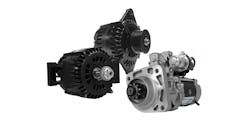“Our work with the University of Michigan is helping us develop the next generation of Ford hybrids and bring them to market even faster.” –Ryan McGee, supervisor of vehicle controls architecture and algorithm design at Ford Motor Co.’s Research and Advanced Engineering group
OK – it’s no secret that the Japanese (specifically Toyota) beat U.S. automakers to the punch with hybrid vehicles. However, that situation is changing – and changing fast – as Ford Motor Co. and General Motors are now quickly deploying more fuel efficient hybrid vehicles across a range of models.
And that could be very important as fuel prices still demonstrate extreme volatility, even as the global recession continues to tamp down petroleum demand.
For starters, Ford and the University of Michigan are working together to speed up “virtual testing” of hybrid components; conducting as many as 175,000 design simulations of hybrid control systems a week to further improve fuel efficiency and drivability.
Researchers at both Ford and the university are also analyzing data from 2,500 road trips to determine how internal electronic vehicle controls could be tweaked to further improve fuel efficiency and fun-to-drive attributes.
So far, Ford and the university have tested nearly 1 million design simulations of hybrid vehicle control systems to date, focusing on marrying fuel economy and drivability.
Though this “virtual research” of hybrid technology is still in its infancy, the automaker says initial results are promising.
“Working together with the University of Michigan research team, we are testing the boundaries of hybrid vehicle technology, exploring innovative ways to raise the bar on fuel economy and drivability,” said Dr. Gerhard Schmidt, chief technical officer for Ford’s Research and Advanced Engineering group.
[Here’s a look at Ford’s 2010 Fusion Hybrid sedan and how new designs seek to improve driver understanding of fuel saving options.]
Through September, Ford has sold 26,016 hybrid vehicles, up 73% versus the same period in 2008, according to figures from Autodata Inc. Moving forward, Ford said it also plans to produce a pure battery electric version of its new Transit Connect commercial van in 2010, a battery electric Focus compact car in 2011, and a plug-in hybrid electric vehicle and next-generation hybrid electric vehicle in 2012.
GM is following a similar path, using new math and simulation-based tools from private sector firm MathWorks to speed up its hybrid development process. GM noted it developed the next-generation prototype of its "Two-Mode" hybrid powertrain control system in 9 months using these “virtual testing” tools – shaving 24 months off the expected development time.
Also, by verifying the control system before hardware prototyping and by using production code generated from the controller models, GM said it rolled out production vehicles featuring the hybrid powertrain within four years of starting the control system design process. To date, its complex two-mode hybrid system is currently available with the GMC Sierra Hybrid, GMC Yukon Hybrid, Chevy Tahoe Hybrid, Chevy Silverado Hybrid, and Cadillac Escalade Hybrid vehicles.
The ability to reuse design information has helped GM’s global development teams foster more efficient communication and reduced response time, eliminating integration issues, said Larry Nitz, GM executive director of hybrid and electric powertrains.
“It helps us work at a higher level of abstraction, allowing us to verify designs early,” he noted “This ability to simulate and correct systems before committing to hardware allows us to try new control strategies virtually, while the use of production code generation accelerates design iterations and eliminates translation errors common in hand coding.”
In the end, it all boils down to one thing – delivering more fuel efficient hybrid vehicles to the market faster and with (hopefully) higher initial quality. That in turn will hopefully encourage wider sales of hybrids by consumers and thus lead to a reduction in U.S. petroleum consumption. That’s the hope hybrid technology offers -- at least from where I sit.



